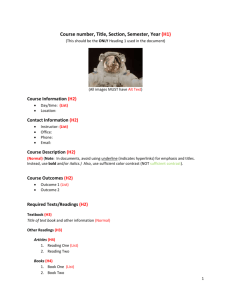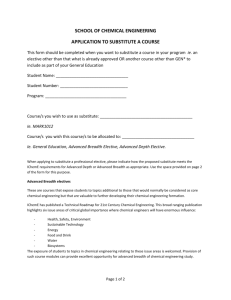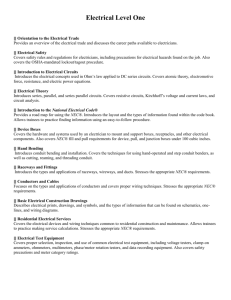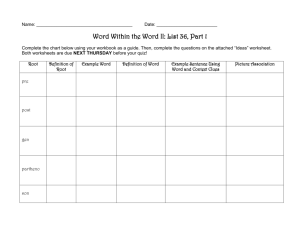Why NEC when you can IChemE - King's College Construction Law
advertisement
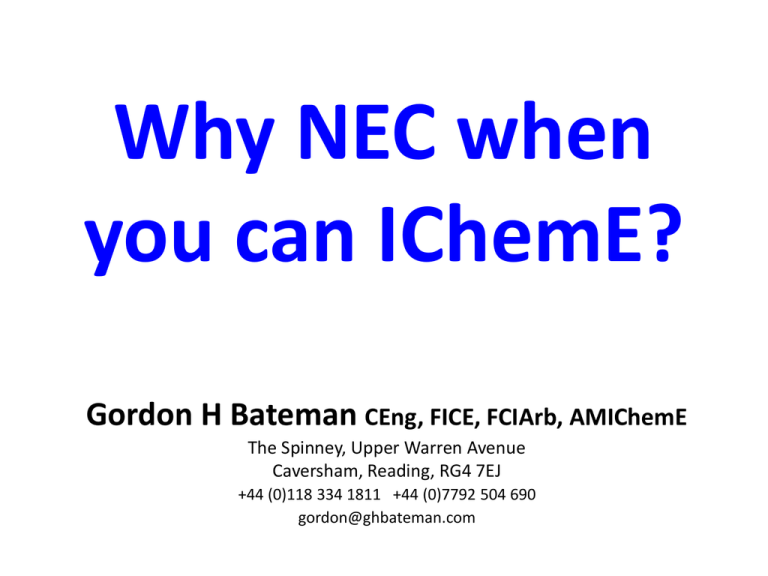
Why NEC when you can IChemE? Gordon H Bateman CEng, FICE, FCIArb, AMIChemE The Spinney, Upper Warren Avenue Caversham, Reading, RG4 7EJ +44 (0)118 334 1811 +44 (0)7792 504 690 gordon@ghbateman.com Why NEC when you can IChemE? Introduction NEC ECC appropriate for all engineering & construction projects? OGC recommends “the use of NEC3 by public sector construction procurers on their construction contracts” What sort of projects? © Gordon H Bateman 2010 2 Why NEC when you can IChemE Examine use of NEC and IChemE forms • Contract for a power station • Also FIDIC Yellow Book (C of C for Plant & Design-Build) © Gordon H Bateman 2010 3 Why NEC when you can IChemE A gas-fired turbine generator power station • Natural gas or LNG via associated plant • Often used for peak-load demand • Cost: eg £500M for Scottish Power 1,000 Megawatt project in Kent in 2009 (The Guardian online) © Gordon H Bateman 2010 4 Why NEC when you can IChemE Technology is gas-fired turbine + generator • Critically whole plant includes sophisticated control systems, complete Plant is SYSTEMS BASED • Systems to operate & control the plant • High level switching-on & synchronisation with grid • Detailed level of opening valves, ignition of gas • Operation and monitoring of performance • Complex & sophisticated system & sub-system based plant • Patents, software and confidentiality issues © Gordon H Bateman 2010 5 Why NEC when you can IChemE Basic requirements to be stated: • Required power outputs • Maximum CO2 emissions at various power outputs • Assumed calorific value of fuel gas • Start-up response time • Guaranteed efficiency to be stated (eg Cal/kWh) • Etc etc © Gordon H Bateman 2010 6 Why NEC when you can IChemE Contract to take fully into account complexity of plant • In the technical Specification • In the Conditions of Contract and overall ‘structure’ of the Contract • NEC ECC, FIDIC Yellow or IChemE? • (Not considering alternative payment mechanisms) © Gordon H Bateman 2010 7 Why NEC when you can IChemE Key factors to consider: 1. What is the Contract? 2. What are the design obligations? 3. What provisions are there for dealing with complex plant issues? © Gordon H Bateman 2010 8 Why NEC when you can IChemE 1. What is the Contract? • ££M contract needs clarity • What is the Contract? • What documents form Contract? © Gordon H Bateman 2010 9 Why NEC when you can IChemE 1. What is the Contract cont’d NEC ECC: • No statement as to what documents form Contract • Conditions of Contract refer to Contract Data, Works Information, Site Information, Schedule of Cost Components • Contract Data specifies which clauses apply (plus ‘Z’ clauses) + data (eg dates, periods, LDs etc) + says where other documents are • Do these five documents “form the contract”? • But no mention of Form of Tender / Acceptance Letter / Form of Agreement • Conflict or ambiguity? Precedence / Contra proferentum © Gordon H Bateman 2010 10 Why NEC when you can IChemE 1. What is the Contract cont’d In contrast: • FIDIC & IChemE state documents forming the Contract + order of precedence • Contract includes Form of Agreement (provided) • FIDIC also includes Letter of Tender & Appendix (provided) Clarity of contract essential © Gordon H Bateman 2010 11 Why NEC when you can IChemE 2. Design liability • NEC: design parts which Works Info says to design (21.1) • FIDIC: in accordance with Laws of Country, the Contract, & to Country’s technical standards etc (5.3, 5.4) • IChemE: fitness for purpose stated in Specification (3.4) Fitness for intended purpose: IBA v EMI & BICC (1980) (NEC: Option X15) © Gordon H Bateman 2010 12 Why NEC when you can IChemE 3. Construction / erection / testing provisions Power station plants are sophisticated and complex Testing requirements: • Off-Site & other pre-installation inspections & tests • On-Site construction/assembly completion inspections & tests • On-Site put to work inspections & tests (pre-takeover) • On-Site post-takeover performance tests Testing requirements much more than in a civil engineering contract © Gordon H Bateman 2010 13 Why NEC when you can IChemE Testing provisions in NEC ECC • Tests & inspections to be in Works Information (40.1) • Tests & inspections by Contractor or Supervisor (40.3) • Test failure = Defect; Contractor to correct & re-test (40.4) • Contractor bears cost of repeat test (40.6) • 31/3 lines re off-Site tests & inspections (41) © Gordon H Bateman 2010 14 Why NEC when you can IChemE Testing provisions in NEC ECC Contd • Searching & notifying Defects (42) • Defect correction (43) • Cost of Defects not corrected by defects date (44 & 45) © Gordon H Bateman 2010 15 Why NEC when you can IChemE Testing provisions in NEC ECC • Contd Low performance: “If a Defect included in the Defects Certificate shows low performance with respect to a performance level stated in the Contract Data, the Contractor pays the amount of low performance damages stated in the Contract Data.” (X17) • Hence everything to be stated in Contract Data + Works Information © Gordon H Bateman 2010 16 Why NEC when you can IChemE Other provisions in NEC ECC • Takeover: not to be early; otherwise 2 wks after Completion (35.1) • PM certifies Completion (30.2) and takeover (35.3) • Completion = single objective of Contractor • Takeover = passing of care & risk • Nothing in X17 re how low performance established, who conducts tests, when tests done, evaluation of test results etc. • Lot of detail left to Works Information authors © Gordon H Bateman 2010 17 Why NEC when you can IChemE Testing provisions in FIDIC Yellow Book • Takeover follows satisfactory completion (10.1) • exceptions at 9.4 • Taking-Over Certificate records when Works complete (10.1(a)) • Unlike ECC FIDIC has just one certificate re completion & takeover © Gordon H Bateman 2010 18 Why NEC when you can IChemE Testing provisions in FIDIC Yellow Book Cont’d Tests after Completion (12): • Carried out by Employer (12.1(b)) • Non-performance damages for failure payable (12.4) • Payment of non-performance damages Works deemed to have passed Tests after Completion (12.4) • Failed tests: Contractor to have access to remedy (12.4) • If no access by end of Defects Notification Period, Works deemed to have passed Tests after Completion (12.2) • No certificate to record position © Gordon H Bateman 2010 19 Why NEC when you can IChemE Testing provisions in IChemE forms Off-Site and pre-installation tests (22 + Sch 13) • Notices of carrying out of tests (22.3) • Provision re non-specified tests (22.4) • Consequences of test failure (22.6) • PM can pass rights to duly authorised nominee (22.7) © Gordon H Bateman 2010 20 Why NEC when you can IChemE Testing provisions in IChemE forms Cont’d Completion of construction tests (32 + Sch 14) • Clearly defined milestone in contract • Every element to be inspected/tested (32.2) • Certificate of Completion of Construction (32.3) • Both for every element or part + whole Plant (32.3 & .5) • “Does this element of the Plant work such that it is likely that the Plant will work?” © Gordon H Bateman 2010 21 Why NEC when you can IChemE Testing provisions in IChemE forms Cont’d Takeover tests & takeover (33 + Sch 15) • Contractor puts plant to work (33.2) • Takeover tests and procedures (33.2) • “Does the Plant work?” • Output, CO2 emissions, etc • Success + O&M Manuals Take Over Certificate (33.7 & 21.9) • Failure Contractor has to put it right (33.5) • TOC = Purchaser has beneficial use + care etc of Plant © Gordon H Bateman 2010 22 Why NEC when you can IChemE Testing provisions in IChemE forms Cont’d Performance tests (35 + Sch 16 &17) How well does the Plant work? • Only if specific guarantees in contract (35.1) • Power station: overall Plant efficiency: Calories of input fuel / kWhr of electricity output • Complete approach: who does tests; when tests done; evaluation of results; re-testing; Contractor to adjust Plant; (35.3 - .8) © Gordon H Bateman 2010 23 Why NEC when you can IChemE Testing provisions in IChemE forms Cont’d Performance tests (35 + Sch 16 &17) Cont’d • LDs only apply up to stated limit; if results outside limit general damages or abatement to apply (35.9) • Limit re LDs can be a degree of deviation or can be failure of another factor – eg quality of output • Acceptance Certificate (36) • • • When performance tests passed or LDs/general damages assessed/agreed No later than end of Defects Liability Period Deemed passing of tests if not done, unless Plant incapable of passing test by reason of C’s default © Gordon H Bateman 2010 24 Why NEC when you can IChemE Comparing testing provisions • IChemE separation of Completion of Construction and T/O very different from ECC & FIDIC • IChemE: many activities (putting to work & commissioning) between Completion of Construction and T/O • Is difference important? • IChemE Completion of Construction very important milestone in complex plant contract • Major milestones as in IChemE each need certificates © Gordon H Bateman 2010 25 Why NEC when you can IChemE Certificates: a Conditions of Contract matter • What is importance of a certificate? • Statement by Contract Administrator acting as certifier • Certificate of Completion of Construction: clearly defined statement that Plant constructed such that likely it will work • Take Over Certificate: Plant does work + O&M Manuals, hence takeover • Sophisticated complex systems-based Plant needs two events (Completion of Construction and Takeover) each with certificate © Gordon H Batemanof 2010Conditions of Contract • Hence must be requirement 26 Why NEC when you can IChemE The comparison: a summary ECC: Completion Certificate: practical milestone Take Over Certificate: transfer of liability FIDIC: TOC (on transfer of liability) following Completion IChemE: Completion of Construction Certificate: practical milestone Take Over Certificate: practical milestone + transfer of liability Acceptance Certificate: practical milestone + clarity of liability re damages © Gordon H Bateman 2010 27 Why NEC when you can IChemE The comparison: other factors – IPRs etc ECC: Very limited copyright provision re use of Contractor’s design (22.1) No confidentiality or IPRs/patents provision FIDIC: Very limited confidentiality provision (1.12); Copyright etc of parties’ documents & their use (1.10; 1.11) Mutual indemnities re IPRs/patents (17.5) © Gordon H Bateman 2010 28 Why NEC when you can IChemE The comparison: other factors – IPRs etc IChemE: Full confidentiality clause (20) Mutual indemnities & detailed provisions re copyright & IPRs/patents, licences (software etc), including Subcontractors’ IPRs (8) © Gordon H Bateman 2010 29 Why NEC when you can IChemE The comparison: some conclusions ECC: use for civil engineering works with/without minor plant items FIDIC: use for non-complex plant, not complex plant IChemE: use for complex systems-based plant (+ process plant) © Gordon H Bateman 2010 30 Why NEC when you can IChemE The IChemE forms – some other details • Main contract forms: • Red Book – lump sum • Green Book – cost reimbursable • Burgundy Book – target cost • Subcontract forms: • Yellow Book – process/M&E • Brown Book – civil engineering & building • UK and International versions © Gordon H Bateman 2010 31 Why NEC when you can IChemE IChemE contracts – the documents • Agreement • Conditions of Contract • Part I – General Conditions • Part II – Special Conditions (if any) • Specification • Schedules (19 or 20) In International forms Part II is Particular Conditions which are essential part of C of C Books contain detailed guide notes. © Gordon H Bateman 2010 32


